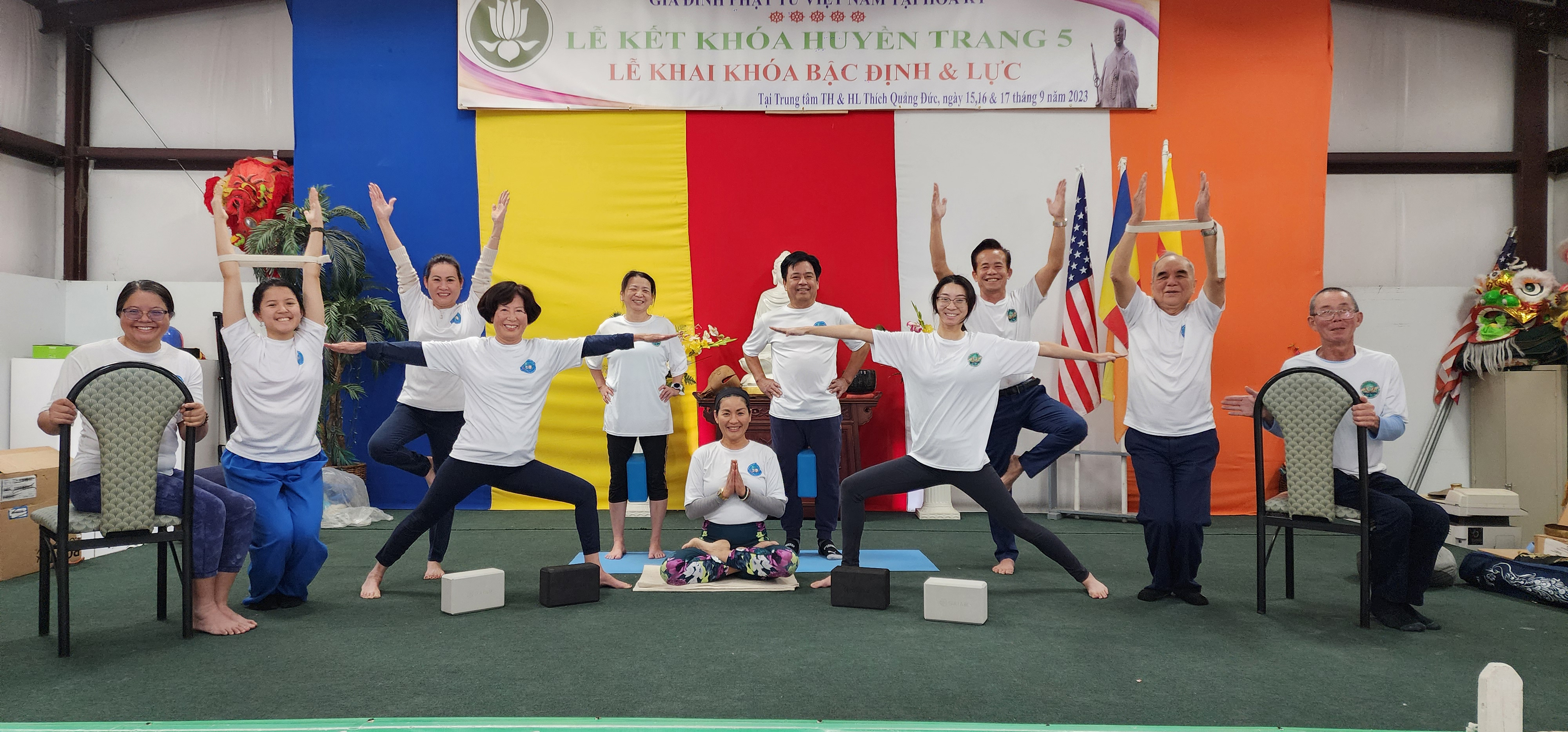GIA ĐÌNH PHẬT TỬ HUYỀN QUANG
NGŨ MINH PHÁP (Five Vidyas - Pancavidya skt) , bài số 2 bậc Kiên
The Five Vidyas (Ngũ Minh Pháp)
Traditionally, the vidyas of ancient India are divided into the five major vidyas which represent the realization of enlightened beings. Besides the five major, there are also the five minor vidyas.
The five major vidyas in the Buddhist context represent the underlying principles of the universe. They are comprehensive and profound and totally encompass everything in the universe with life or without life, the spiritual and the material.
The five major vidyas are:
- Silpakarmasthanavidya (Craftsmanship Vidya)
- Cikitsvidya (Healing Vidya)
- Sabdavidya (Sound Vidya)
- Hetuvidya (Causality or Buddhist Logic Vidya)
- Adhyatmavidya (Inner Realization Vidya)
The five minor vidyas are rhetoric, ornate diction, prosody, dramaturgy, and astronomy.
With these experiences, Gautama Buddha wanted his followers to understand the real concept of the universe. Buddhism organized the five major vidyas as follows:
- Adhyatmavidya (Inner Realization Vidya)
- Hetuvidya (Causality or Buddhist Logic Vidya)
- Sabdavidya (Sound Vidya)
- Silpakarmasthanavidya (Craftsmanship Vidya)
- Cikitsvidya (Healing Vidya)
I. Adhyatmavidya (Inner Realization Vidya)
The inner realization vidya includes metaphysics, psychology, or inner special philosophy (adhyatmavidya), which in this context means knowledge of the ultimate truths of the universe. Buddha pointed out all the directions to the Bồ Tát. The Bồ Tát needs these knowledge and skill sets in order to serve all living beings and societies.
The Bồ Tát also needs continuous learning, meditation, mindfulness and contemplation. Understanding the inner realization vidya means that one understands the Tripiṭaka (Kinh - Luật - Luận) as taught by the Buddha and Buddhist Patriarchs who enlightened themselves.
II. Hetuvidya (Causality or Buddhist Logic Vidya)
This vidya is often translated as “logic,” the logic of right and wrong, real and fake. It is the logic of the Law of Cause and Effect. Understanding this principle can enable you to see both past (causes) and future (effects). This logic of science is related to the root of the universe: earth, water, energy, and air.
In the past, this logic was limited and controlled by morals and philosophy, but now it points to all areas: mathematics, physics, chemistry, nuclear physics, computer science, and all basic logic used for mechanics and industries.
Buddha pointed to a lamp and explained that the darkness and lightness of this lamp create different karmic reactions. There is one effect if the lamp is lit and another if it is turned off. When the lamp is in different positions, it also creates different effects.
We pick up a teacup and we already feel the cause and effect of drinking the tea. Taking the lid off a teacup is the cause. Vapor or steam arising from the tea is the effect. Taking the cup in our hand and bringing it to our mouth is the cause. Quenching our thirst is the effect.
Buddha has given many examples of how this principle works: from small causes that result in a single hair falling, to the collective karma of many people, resulting in great prosperity or disaster.
The causality vidya relates to all matters and all dharma, all levels of conditional and unconditional phenomena, the entire logical relationship among them, the relationship of cause and effect, and so on. What the causality vidya covers is countless.
III. Sabdavidya (Sound Vidya)
A. Definition of Sound Vidya
- Explaining grammar and assay in languages. This is a study of all communication methods: language, writing, modern technology like television, telephone, email, etc.
- Sound vidya means communication: The Buddha recognized that communication was most essential; without it, we cannot study any other areas. Like today, communication in the past was written or verbal. The Buddha always encouraged people to learn how to teach others. Therefore, we need to learn common languages in addition to our own to share ideas between nations and improve each other’s lives spiritually and materially.
B. Communication Techniques
- Verbal communication.
- Written communication: The growth of civilization depends upon those books from many generations from the past. Buddhism started from India, therefore, most of Buddha-Dharma was written in Sanskrit. Later on, the Buddha-Dharma was translated to Chinese. Currently, Vietnam’s Buddha-Dharma is translated either directly from Sanskrit or Chinese.
- Other ways of communication: Some may argue that the Buddha’s ultimate true principle cannot be expressed by language, but if we are not using language then Buddha-Dharma will never spread. Even the Buddha’s ultimate truth is above and beyond configuration, we must use some kinds of configuration in order to present the Buddha’s idea. It could be presented by arts, sculpture, music, and action similar to the Tibetan Buddhists. In meditation, the way of passing on the ultimate wisdom is through mind to mind. However, due to the different level of experiencing and understanding Buddha-Dharma, language and visual communication are still the best and most effective ways for the majority of the Buddhist population.
IV. Silpakarmasthanavidya (Craftsmanship Vidya)
- This vidya refers to art and mathematics, including the ability to create works of art like sculpture or painting, astronomy or geography, architecture or technological innovations at the Buddha’s living time. Nowadays, craftsmanship vidya expands to civil development, transportation, energy, business, and more.
- It is also called industrial vidya. According to Professor Trieu Chan Giac, craftsmanship vidya used to refer to art and mathematics, but today it includes technology and mechanical sciences. Innovations in agriculture to grow better food, cotton for fabrics, city development, and the automobile industry to improve transportation all belong to craftsmanship vidya because they are necessary to daily life. People used astronomy and geography to predict weather, which affects food growth. Math is used to calculate materials for cities and house construction.
- It not only includes the ability to create works of art or technological innovations, but also any expression of oneself—from a frown or smile to the makeup and clothes one wears.
- The craftsmanship vidya is much more than merely painting. If it were only a craft like painting, then should Yun sculptures not be included? Should artistic sculptured landscapes not be part of craftsmanship vidya? Should the alteration and tailoring of clothing likewise be excluded? All of these, in fact, are part of the craftsmanship vidya.
Everything that is beautiful and artistic is included within the craftsmanship vidya. Whatever brings enjoyment and happiness to people is part of it. Sitting in a dignified manner, as straight as a bell, totally conforming to the appearance of a member of the sangha, is also part of this vidya. The craftsmanship vidya contains manifold changes. In short, anything that embodies goodness and art belongs to this vidya.
You are smiling with your mouth lightly closed. At that time, your expression is part of the craftsmanship vidya. The falseness or trueness of what you express outwardly and feel inwardly are also part of this vidya. If you did not have a certain inner feeling, then you would not smile with your mouth lightly closed. In your heart or mind, you lack art. You only know to smile—thus, you lack craftsmanship.
The craftsmanship vidya represents two aspects: our outward expression and our inner spirit. Our spirit is included in the craftsmanship vidya. Take, for example, someone whose spirit is full. How is it full? Such a person is very self-confident and feels their expression of spirit is beautiful. This is part of the craftsmanship vidya.
Some actors have stage fright. Although on the surface they appear to possess craftsmanship, their spirit lacks it. When others take the stage, they not only look the part, but their spirit is also full. They think they will be the best. This fullness of spirit is part of the craftsmanship vidya. This is extremely profound.
V. Cikitsvidya (Healing Vidya)
- This vidya refers to medical technology and medicine. During the Buddha’s time, this vidya included medical treatments, internal medicine, and basic illness prevention. Today, healing vidya includes biology, pharmacy, surgery, psychology, and other fields that both mentally and physically treat illness.
- This vidya is listed as medicine or the healing vidya and includes all aspects of what we normally think of as medicine: the diagnosis of illnesses and their healing. It also includes taking anything that is coarse or rough and refining or correcting it— whenever something goes from a bad state to a better state. The healing vidya includes all activities that improve a situation or thing. For example, revising a draft manuscript, repairing a clock, or any other revision, repair, alteration, or activity that raises the quality of something is part of this vidya. Anything that is refined or changed to be good is considered part of the healing vidya in this ancient way of understanding universal principles.
- Even your act of taking notes on this discourse is an example. When you go back and refine your notes to produce this web page—that’s the healing vidya. If you give a discourse based on these notes, you will use your mastery of the sound vidya to deliver it.
VI. Conclusion
The five vidyas in the Buddhist context represent the underlying principles of the universe. They are comprehensive and profound, and totally encompass everything in the universe—with life or without life, the spiritual and the material. Everything—all dharma—is contained in the five vidyas. All form and formless, active and inactive phenomena in the entire universe are expressed within them.
It is essential that they be understood and mastered, if one is to obtain the full power of the Buddha-Dharma. These five vidyas are not merely Buddhist truths or knowledge areas—they are the underlying principles of truth and the original nature of all phenomena. They represent the entire interrelated Truth of the Universe.
These five vidyas were not created, changed, or altered by the arrival of the Buddha. That is why Buddha’s Holiness has told us that it is heresy to refer to the five vidyas as merely five sciences or areas of knowledge.
Every Huynh Trưởng must clearly understand the five vidyas, especially the Inner Realization Vidya (Adhyatma Vidya), because it is the hardest to understand and also the most unique to Buddhism. As a Huynh Trưởng, we are not only learning the Buddha-Dharma but must apply and practice these teachings in our daily life in order to gain self-proficiency in all of these areas.
The five vidyas must be understood and mastered by each Huynh Trưởng in order to guide our youth to achieve the ultimate goal: the ending of suffering.
 CHU NIÊN
CHU NIÊN
 PHẬT ĐẢN
PHẬT ĐẢN
 VU LAN
VU LAN  TRẠI HÈ
TRẠI HÈ  VIỆT NGỮ
VIỆT NGỮ  YOGA
YOGA VOVINAM
VOVINAM GÂY QUỸ
GÂY QUỸ MỞ MẮT
MỞ MẮT  CHÂN CỨNG
CHÂN CỨNG  CÁNH MỀM
CÁNH MỀM  HƯỚNG THIỆN
HƯỚNG THIỆN  SƠ THIỆN
SƠ THIỆN  TRUNG THIỆN
TRUNG THIỆN  CHÁNH THIỆN
CHÁNH THIỆN  BẬC HÒA
BẬC HÒA  BẬC TRỰC
BẬC TRỰC